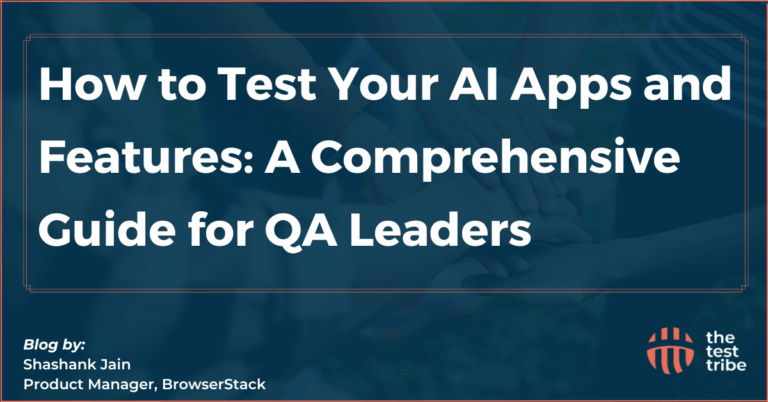As Artificial Intelligence (AI) becomes deeply embedded in decision-making across fraud detection, chatbots, and virtual assistants, trust in AI agents is now critical. Users and stakeholders need clear assurance that these systems will behave fairly, clearly, evidently, and reliably in all situations.
However, building that trust does not happen by chance; it requires smarter testing strategies specifically designed for the non-deterministic and robust nature of AI. This blog explores how software developers and QA professionals can utilize intelligent testing techniques to validate AI behavior, ensure ethical outcomes, and ultimately foster trust in AI-centric systems.
Why Trust in AI Agents Matters?
As AI-based systems become increasingly integrated into everyday products, such as recommendation systems, autonomous decision engines, and customer service bots, trust is emerging as a crucial success factor. No matter how sophisticated the algorithms are, if developers, stakeholders, testers, or users can’t trust an AI agent’s behavior or decisions, acceptance and long-term value suffer.
Key Statistics on AI Agent Trust
Gartner forecasts that by the year 2027, AI agents will improve or automate 50% of business decisions, making trust not optional but foundational. Businesses that invest in executive AI literacy are estimated to attain 20% higher financial performance.
Trust in AI agents surpasses tech performance. It includes fairness, certainty, transparency, and accuracy. A seemingly minor difference in an Artificial Intelligence (AI)’s behavior in multiple contexts can rapidly undermine trust. For instance, if a chatbot offers useful data one day but biased or unclear answers the next, customers are less inclined to use it going forward.

Business-wise, a lack of confidence in AI results in friction in deployment, potential harm to one’s reputation, and increased expenses for human oversight. Furthermore, authorities are becoming more demanding when it comes to explainability and accountability in AI systems, making trust a compliance issue as well as a user experience one.
Smarter testing is essential to fostering trust. It confirms AI agents in testing act logically, consistently, and openly in a suite of real-world circumstances. It goes beyond checking correct results, focusing instead on validating the decision boundaries, context awareness, and logic that make AI behavior reliable.
How to build trust in AI-powered agents?
Confirm Explainability
Use understandable AI (XAI) techniques to assist stakeholders and customers in comprehending when, why, and how assumptions are made.
Key Techniques in XAI to Establish Trust
- Model-Agnostic Explanation Methods: These approaches work separately from the underlying AI algorithm and can be applied across distinct models, such as LIME (Local Interpretable Model-agnostic Explanations) and SHAP (SHapley Additive exPlanations):
- Interpretable Models by Design: Some algorithms are more transparent than others, like linear/logistic regression models or decision trees and rule-based systems.
- Surrogate Models: These are simplified models that approximate the complex system’s behavior for explanation.
- Counterfactual Explanations: This approach answers, “What are the things that need to be changed in the input for the AI agent to make a dissimilar decision?”
- Visual Explanations: For video, image, or UI-based models, visual explainability tools such as Gradient-weighted Class Activation Mapping (Grad-CAM) or Saliency Maps help users see which section of an input image or UI screenshot influenced a classification or prediction.
Perform Smarter Testing
Execute adversarial, fairness, and behavioral testing to confirm the behavior of AI across diverse user groups and situations.
- Adversarial Testing—This reveals how resilient the artificial intelligence is against unprojected or manipulated data, like ambiguous commands, typos, or malicious inputs.
- Example: Testing how an AI chatbot responds to misspellings, slang, or conflicting commands might reveal negative results or faulty reasoning.
- Fairness Testing—Fairness testing assesses whether the system’s decisions vary across traits like gender, race, language, disability status, or age.
- Example: An AI-centric hiring assistant shouldn’t favor specific accents, names, or geographies if trained properly. Fairness testing helps find and address such biases.
- Behavioral Testing—It assesses whether the artificial intelligence makes decisions for the proper reasons, based on ethical and logical patterns, chiefly under diverse situations.
- Example: This type of testing could ensure that a fraud detection system reliably identifies fraudulent transactions across nations without producing false positives based solely on location.
Audit for Fairness and Bias
Frequently evaluate training information and model outcomes for bias to avoid skewed decisions. The objectivity of AI systems depends on the logic and data they are based. Because of this, auditing for bias and fairness is a continuous activity that spans the entire AI lifecycle, rather than a one-time event. It ensures that model decisions are fair to all user groups, particularly those who have traditionally been underrepresented or marginalized.
How to Audit AI for Bias and Fairness:
- Analyze the Training Data for Representation Gaps
- Use fairness metrics like disparate impact ratio, demographic parity, etc.
- Run Bias Audits on Model Outputs.
- Include manual review.
- Retrain or Fine-Tune with Balanced Data.
- Document All (Datasheets/Model Cards).
Allow Regular Assessment
Assess AI performance to detect flaws, data drift, or unpredictable behaviors. Key benchmarks and parameters to examine:
- Accuracy & Model Performance Metrics
- MAE, RMSE, R²—For regression issues (for example, demand forecasting).
- Precision, Recall, and F1 Score—For classification works (for instance, fraud exposure and sentiment analysis).
- Top-k Accuracy—For multi-class outcomes or recommendation engines.
- Data Drift & Concept Drift
- Concept Drift: Occurs when the relationship between output & input fluctuates over time.
- Data Drift: Occurs when the input data is modified in distribution from the original training data.
- Fairness Metrics
Assess consistency across demographic groups:- Disparate Impact
- Equal Opportunity Difference
- False Negative/Positive Rates by Group
- Confidence & Explainability Scores
Confirm predictions aren’t just correct but also explainable.- Examine the confidence intervals of predictions.
- Use LIME, SHAP, or Integrated Gradients to find overfitting or logic anomalies.
- User Reaction & Human-in-the-Loop (HITL) Corrections Track:
- AI forecasts are manually corrected.
- The frequency of human agents overriding
- End-user dissatisfaction signals (for instance, support tickets)
- Scalability, Latency & Uptime For deployed agents, operational metrics such as,
- Response Time
- Scalability Under Load
- Uptime/Availability
Use Trusted Platforms and Frameworks
Leverage test automation tools that support explainability, automation testing, and AI observability.
Endorse Ethical AI-Based Design
Follow ethical principles and keep proper records of the model’s purposes, restrictions, and data sources.
Core Principles of Ethical AI
Most ethical frameworks, whether from the EU AI Act, OECD, IEEE, or companies such as IBM, Microsoft, and Google, center around these 7 fundamental principles:
- Transparency
AI decisions should be traceable and understandable. - Accountability
There should be a responsible human to identify errors in the AI system. - Non-Discrimination & Fairness
AI should not simulate or reinforce biases based on disability, age, gender, race, or other estimated characteristics. - Data and Privacy Governance
Respect users’ privacy through purpose-centric data use and anonymization/pseudonymization. - Reliability & Safety
AI systems should be robust against adversarial attacks and manipulation. - Inclusiveness
Design with language diversity, accessibility, and cultural sensitivity in mind. - Sustainability
Consider the environmental effect of AI development and effective model architectures (such as TinyML, pruning, etc.).
What are the best practices for testing AI agents to build user trust?
1. Audit for Transparency and Bias
- Assess training facts and outputs across demographic groups.
- Make use of fairness toolkits (for instance, IBM AIF360) to identify & correct bias.
Example: A lending AI-based model is tested through IBM AIF360. It indicates that more applications from a specific ZIP code were being turned down. To attain parity in results, the team re-runs the audit and retrains using balanced data.
2. Test for Explainability
- Explain model outputs using tools like SHAP, LIME, or the What-If Tool.
- Make sure people can comprehend the reasoning behind the AI’s choices.
Example: An AI that prescribes drugs makes a forecast based on patient information. SHAP emphasizes that the decision was influenced by age and prior medical issues, which helps physicians validate and believe the advice.
3. Use Stress & Adversarial Testing
- Feed intentionally flawed or challenging inputs to discover risks.
- Make sure AI agents maintain their predictability and safety in the face of stress.
Example: A chatbot is perfectly tested with malicious prompts such as “DROP TABLE users;” to confirm it does not leak information or execute unintended commands.
4. Conduct Behavioral Testing
- Evaluate AI behavior in a range of situations, edge cases, as well as inputs.
- Make certain that the AI responds properly, reliably, and morally.
Example : To make sure a fraud detection system doesn’t mistakenly flag or stop legitimate transactions, it is tested using purchases made by foreign nationals and unusual spending patterns.
5. Implement Continuous Assessment
- Use tools that identify abnormalities or model drift to track AI performance in practical contexts.
- Configure alerts for unpredictable patterns or sudden behavioral shifts.
Example: EvidentlyAI detects abrupt changes in product classification accuracy following an e-commerce AI implementation. Using more recent product data, the team retrains the model.
6. Incorporate Testing with Humans in the Loop
- Review outcomes and decisions for high-risk use cases with domain specialists.
- With domain specialists, review results and options for high-risk use cases.
Example: Doctors evaluate edge-case outputs in a medical triage AI. In order to improve the model during retraining, they also log their disagreements.
7. Record AI Limitations & Behavior
- Keep users informed about what the AI in software test automation can and cannot do.
- Make the boundaries, data sources, and model assumptions clear.
Example: A model for content moderation points out that it might have trouble recognizing subtle language and recommends human review for delicate posts. Its model card contains documentation about this.
8. Implement Responsible AI Frameworks
- Line up with frameworks like the OECD’s AI principles or Google’s Responsible AI.
- Incorporate accountability into the test process.
Example: An HR analytics solution is subject to OECD-compliant ethical principles. Every stage is documented, including audit results and stakeholder approvals.
9. Use Trusted Platforms
- To build faith in AI-assisted systems, platforms like ACCELQ provide intelligent test generation, intelligent orchestration, and risk-centric arrangement.
Example: A financial services company maintains coverage across scenarios, prioritizes high-risk flows using intelligent tagging, and automatically generates fraud model test cases using ACCELQ.
How to ensure your AI agent is trustworthy and free from bias?
1. Begin with Clean, Representative Data
Regularly audit information for unseen biases (for instance, overrepresentation of a demographic).
2. Run Bias Recognition Testing
Utilize tools to test for biases across sensitive attributes such as age, gender, or race.
3. Execute Explainability Methods
Integrate SHAP or LIME to describe separate predictions.
4. Authorize with Actual Situations
Conduct scenario-based & behavioral testing to replicate edge-case inputs.
5. Implement HITL
In intricate or high-stakes situations, allow manual reviewers and implement Human-in-the-Loop for authorizing AI-assisted decisions.
6. Track for Drift and Unplanned Behavior
Regularly monitor AI behavior in production through observability tools.
7. Use Reliable Frameworks and Tools
Supports automating ethical authentications and visual behavior testing.
8. Align with AI Rules
Align with business standards, such as Microsoft’s Responsible AI and Google’s AI ethics testing framework, among others.
Conclusion
Trust is supreme for any successful AI deployment. Whether the AI is a reference engine, chatbot, or fraud detection system, users and investors need to ensure that it is operating fairly.
Building that trust requires more smart testing. To guarantee moral and Trustworthy AI Testing, QA teams can go beyond simple validations by integrating behavioral analysis, bias detection, explainability, and automation. This change is being made possible by platforms like ACCELQ, which give teams the ability to evaluate not only functionality but intelligence itself.





